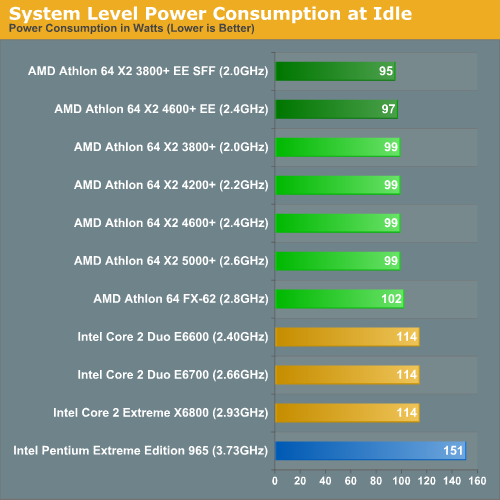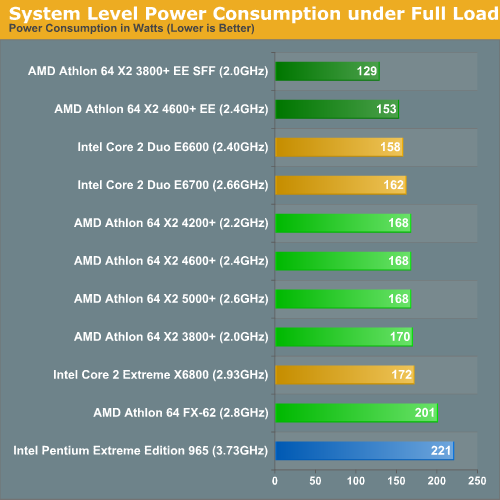Intel's Core 2 Extreme & Core 2 Duo: The Empire Strikes Back
by Anand Lal Shimpi on July 14, 2006 12:00 AM EST- Posted in
- CPUs
Power Consumption: Who is the king?
Intel promised us better performance per watt, lower energy consumed per instruction, and an overall serious reduction in power consumption with Conroe and its Core 2 line of processors. Compared to its NetBurst predecessors, the Core 2 lineup consumes significantly lower power - but what about compared to AMD?
This is one area that AMD is not standing still in, and just days before Intel's launch AMD managed to get us a couple of its long awaited Energy Efficient Athlon 64 X2 processors that are manufactured to target much lower TDPs than its other X2 processors. AMD sent us its Athlon 64 X2 4600+ Energy Efficient processor which carries a 65W TDP compared to 89W for the regular 4600+. The more interesting CPU is its Athlon 64 X2 3800+ Energy Efficient Small Form Factor CPU, which features an extremely low 35W rating. We've also included the 89W Athlon 64 X2s in this comparison, as well as the 125W Athlon 64 FX-62.
Cool 'n Quiet and EIST were enabled for AMD and Intel platforms respectively; power consumption was measured at the wall outlet. We used an ASUS M2NPV-VM for our AM2 platform and ASUS' P5W DH Deluxe for our Core 2 platform, but remember that power consumption will be higher with a SLI chipset on either platform. We used a single GeForce 7900 GTX, but since our power consumption tests were all done at the Windows desktop 3D performance/power consumption never came into play.
We took two power measurements: peak at idle and peak under load while performing our Windows Media Encoder 9 test.

Taking into consideration the fact that we were unable to compare two more similar chipsets (we will take a look back at that once retail Intel nForce 5 products hit the shelves), these power numbers heavily favor Intel. The releative power savings over the Extreme Edition 965 show just how big the jump is, and the ~15% idle power advantage our lower power AMD motherboard has over the Intel solution isn't a huge issue, especially when considering the performance advantage for the realtively small power investment.

When looking at load power, we can very clearly see that AMD is no longer the performance per watt king. While the Energy Efficient (EE) line of X2 processors is clearly very good at dropping load power (especially in the case of the 3800+), not even these chips can compete with the efficiency of the Core 2 line while encoding with WME9. The bottom line is that Intel just gets it done faster while pulling fewer watts (e.g. Performance/Watt on the X6800 is 0.3575 vs. 0.2757 on the X2 3800+ EE SFF).
In fact, in a complete turn around from what we've seen in the past, the highest end Core 2 processor is actually the most efficient (performance per Watt) processor in the lineup for WME9. This time, those who take the plunge on a high priced processor will not be stuck with brute force and a huge electric bill.










202 Comments
View All Comments
arachimklepeto - Tuesday, July 25, 2006 - link
And what about noise Core 2 Duo fan(decibels)?bmaamba - Tuesday, July 25, 2006 - link
Hi,Acc. to Toms hardware, for EIST to work, setting in Control panel has to be changed from "desktop" to "portable/laptop".AT guys, was this done? If not, how about putting it in the "Power consumed" graphs?(acc. to Tom(if i rem. right), least power in this mode is about 25watts by core 2 duo!!!).Also anyone knowledgeable, is this setting available in Linux?
Also, how about putting XP X2 3800+ EE in the encoding benchmarks (along with core 2 duo 6300)?
Thanks
Ed
PS.Price and power consumed when idle are v. imp. to me.
herkulease - Thursday, July 20, 2006 - link
Unless I missed it what are temps like on these.Justin Case - Monday, July 17, 2006 - link
What the heck is a "composite score"...? What are the units? How about giving us rendering times (you know, minutes, seconds) and render settings, so the numbers actually mean something...?rahvin - Monday, July 17, 2006 - link
Where's a good 64bit comparison on Linux and a LAMP stack run at 64bit? There hasn't been a serious linux server benchmark posted.BikeDude - Sunday, July 16, 2006 - link
I'd love to see some timings from a C++ compiler or two... Looks like I'll have to revise our standard developer PC configuration.--
Rune
kmmatney - Sunday, July 16, 2006 - link
"Jarred that would be great to see. The E6300 and X2 3800+ seem close, but the final AMD pricing and the overclocking potential of each could really make either the clear winner for performance per dollar in the midrange segment."Yes - this is the test that most people want to see. I';m sure a lot of people are like me, and don't much care about any processors over $200. We want to see that the low end can do!! The AMD X2 3800+ is going to be even lower priced than the E6300, so there may be a good battle at teh low cost end.
aznskickass - Sunday, July 16, 2006 - link
Battle? What battle? The war is over my friend. ;)The E6300 wins hands down vs X2 3800+, even more so once both are overclocked:
http://xbitlabs.com/articles/cpu/display/core2duo-...">http://xbitlabs.com/articles/cpu/display/core2duo-...
Jeff7181 - Saturday, July 15, 2006 - link
Would have been nice to see a Core Duo CPU in there too just for comparison for those of us with laptops who might considering spending $200 on a Merom if it would increase performance 10-20% over a Yonah with the same power consumption.IntelUser2000 - Thursday, July 20, 2006 - link
Link: http://www.trustedreviews.com/article.aspx?art=316...">http://www.trustedreviews.com/article.aspx?art=316...
http://www.hardware.fr/articles/623-10/intel-core-...">http://www.hardware.fr/articles/623-10/intel-core-...
Core 2 Duo E6400 2.13GHz is approximately 15% faster than Core Duo T2600 2.13GHz, in addition to the fact that 4MB cache versions are 3% in average faster, it looks estimation of 10-20% faster per clock than Yonah is right, even with the 2MB cache version.